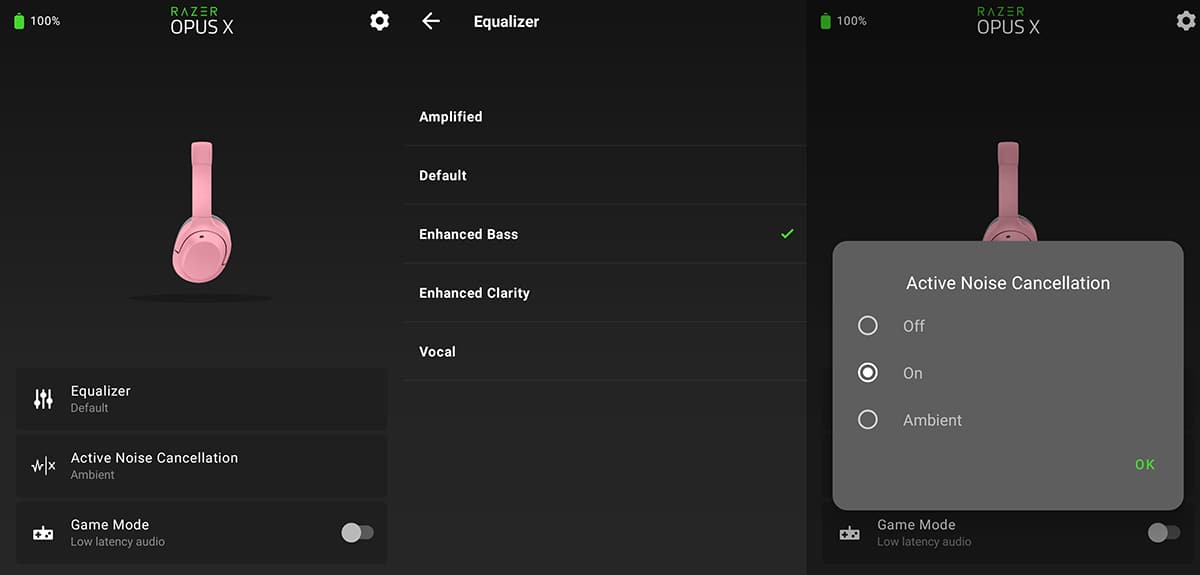Advertiser Disclosure: At Slickdeals, we work hard to find the best deals. Some products in our articles are from partners who may provide us with compensation, but this doesn’t change our opinions. Our editors strive to ensure that the information in this article is accurate as of the date published, but please keep in mind that offers can change. We encourage you to verify all terms and conditions of any product before you apply.
Reading Time: 6 minutesContinuing its expansion into consumer audio, Razer recently released the Opus X wireless active noise cancellation (ANC) headset. This follows hot on the trail of the original and more premium Opus headphones, which features THX certification and advanced ANC.
The “X” in the Opus X means you’ll get the same core performance you’d expect from a Razer product, but offered with a lower price point so it’s even more accessible.
But are Razer’s claims too good to be true for Opus X, especially when the regular retail price is just $99.99? Let’s see how this Quartz Opus X fares through my daily grind of working remotely and playing on my phone and tablet.
Shop Opus X:
Razer Opus X Technical Specifications
- Frequency Response: 20 Hz – 20 kHz
- Driver Size: 40mm
- Circumaural ear cups made of protein leather/nylon
- Active Noise Cancellation
- Bluetooth 5.0
- Weight: 270g
- Microphone: 2 for active noise cancellation technology, 2 for voice chat
- Battery Life: Up to 30 hours with ANC on (up to 40 hours with ANC off)
Designed for Enthusiasts
At first glance, I can’t help but notice that the Opus X shares a ton of physical similarities with Sony’s WH-1000XM3 headphones, which are widely regarded as one of the best standards for wireless ANC performance. But that’s a good thing, though, because it means I’m pretty much guaranteed a comfortable fit based on my experience with the Sony headphones.
The Opus X features plenty of padding at the top, the ear cushions are soft and fit securely around my ears, and the overall structure applies enough pressure to be snug but not too tight. Because the external surfaces feature a matte texture that’s achieved by the actual material itself — as opposed to a clear coating — the headphones feel a bit toy-ish to the touch. But in every practical sense, the Opus X is sturdy and well-constructed — nothing about it feels fragile.
And my favorite aspect is that it comes in bold colors: Quartz and Green. Of course, there’s also Mercury for those who appreciate subtlety.
Physical buttons on the right ear cup provide easy access to all of the Opus X’s functions, including ambient pass-through, gaming mode, voice commands, and phone calls. The only thing that’s missing is the ability to mute the mic.
Class-Leading Audio Performance
I’m just gonna come out and say it — the Opus X sounds really good! It produces plenty of rich bass along with clear tones and a mix/balance that will satisfy most people’s musical tastes. Plus, the ANC is effective in blocking unwanted sounds without making me feel like I’m in a vacuum.
And although I’ve experienced lots of headphones thanks to this line of work, I recognize that my opinion is limited to my unique sensitivities and affinities. So, to better illustrate the audio performance of the Opus X, I’m going to directly compare it to my personal pair of Sony WH-1000XM3 as it’s often positioned as “the one to beat.”
I wore the two pairs of headphones back-to-back with the same songs on repeat, and even asked my partner to participate in a blind listening test.
At the end of our tests, we both concluded that the Sony WH-1000XM3 sounded better, but only by a very small margin. If I had to put a number to it, I’d say the Opus X is just 10% behind Sony in regards to an overall musical experience. Sony offered a tad more immersion, subtly better details, and a slightly fuller sound. This should come as no surprise as Sony is a legendary brand in the music industry.
Although we both marginally preferred the Sony headphones over the Opus X, Razer still accomplished quite a feat for producing a $100 headset that achieves similar performance to a pair of headphones that launched with a price tag of $349. Plus, the only reason I’m able to be picky about Opus X is because I also own said $349 pair of headphones. I wouldn’t be able to identify any deficiencies in a stand-alone setting, and I’m confident that if I slapped Opus X over anyone’s head on the street, they’d have a bangin’ time with their music.
Additionally, the Razer Audio mobile app offers sound customization options with five EQ settings: Default, Amplified, Enhanced Bass, Enhanced Clarity, and Vocal. Unfortunately, full equalizer control isn’t offered, much to the dismay of audio enthusiasts, but I think most people will be satisfied with Default or Enhanced Bass.
For More Than Just Music
Opus X is best enjoyed on-the-go, and Razer has included lots of features geared towards this lifestyle. First and foremost, Opus X is lightweight and comfortable enough to be worn for hours on end. I easily spent an entire work day with mine on, taking Zoom meetings, making phone calls, watching YouTube, etc.
The built-in microphone delivers clear sound for the receiving party — according to numerous friends, my voice isn’t over-filtered, and background noise doesn’t get picked up. The multiple mics are also utilized in Quick Attention mode to enhance awareness of your surroundings.

Credit: Honkai Impact 3rd
For mobile gamers, Razer has included a low latency mode that enhances the connection so audio and visuals sync better. I could really see the performance difference when playing an action game like Honkai Impact 3rd, and further confirmed the lag reduction with an audio/video sync test on YouTube.
A few compromises were made, though, in Razer’s quest to maintain Opus X’s low price. The most apparent is the lack of a carrying case. Inside the retail packaging, it’s just the headphones and a color-matched USB-A to USB-C charging cable. A 3.5mm audio jack has also been omitted, so you won’t be able to enjoy an airplane’s in-flight entertainment system. Lastly, Opus X can only be connected to one Bluetooth device at a time. You’ll need to enter pairing mode each time you want to switch devices.
None of these trade-offs were a deal breaker for me, though, especially when I take into account Opus X’s affordability.
Should You Buy the Razer Opus X?
For those wanting solid ANC audio performance, colorful expressions, and a better way to play mobile games, Razer’s Opus X is a fun lifestyle solution. These headphones more than met my needs, and the Quartz color garnered lots of attention and compliments from my coworkers.
Sure, there are other headsets with more premium features, but the Opus X excels at the most important duties of wireless headphones — audio quality, ANC, connection stability, comfort — while keeping you at a budget of $100.
Razer’s Opus X is available now for $99.99 and comes in Mercury, Quartz, and Green colors.
Shop Opus X:






































